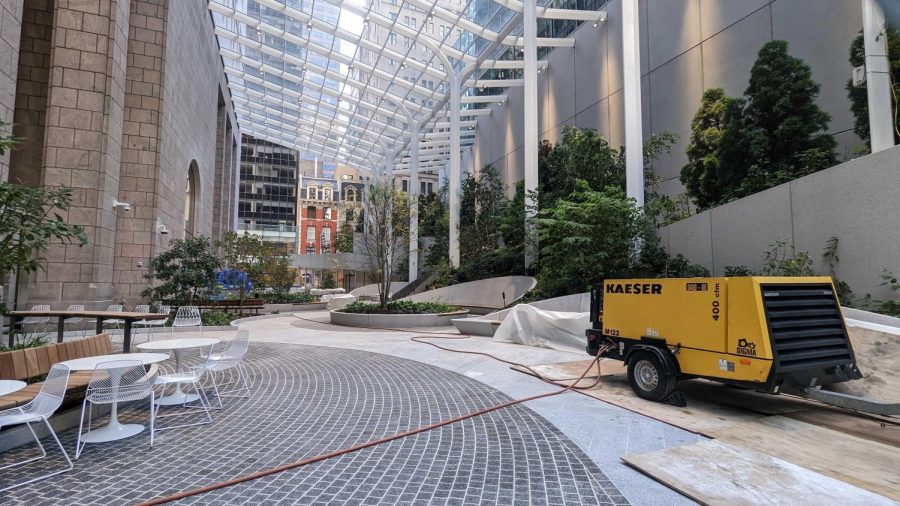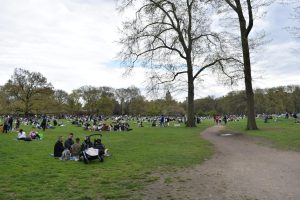The Public Garden at 550 Madison Comes at a Price
Free never really means free when there are corporate interests involved, and the newly renovated green space at the old Sony Building is no exception
Construction is almost finished on the public garden at 550 Madison, a skyscraper in Midtown East.
October 26, 2022
In Midtown East, construction is well underway to expand the open-air greenspace at 550 Madison, a towering skyscraper seated on Madison Avenue between 56th and 57th Streets. The commercial building was acquired in 2016 by the Olayan Group, a multinational investment and contracting group. Olayan is redeveloping the former Sony headquarters, which currently serves as the U.S. headquarters of Hermès, to include a retail center, office space, a multistory corporate penthouse and a public garden at the back of the building.
Before construction, there was an open-air greenspace available to the public at 550 Madison, which developers claim they are nearly doubling in area. The building’s new interior and the garden have been designed by Oslo-based architecture group Snøhetta, which has worked on notable buildings in New York and around the world, including the National September 11 Memorial Museum Pavilion.
The newly expanded public space boasts a concrete and brick-lined veranda dotted with curved wooden benches as well as metal coffee tables and chairs. They are surrounded by tiered platforms populated with bushes and trees, with the entire space sitting under a sloped glass roof supported by thin concrete columns. It is an open-air oasis of organic vegetation in the middle of a concrete jungle, and it is expected to be open to the public within the next few weeks.
More green space is always a plus in midtown Manhattan, where full-sized trees are hard to come by outside of Central Park. Only a block away from the urban decadence of Fifth Avenue, 550 Madison offers a reprieve from the stale air and bustle of the city.
But don’t be deceived — this public garden is no modern-day Eden. Rather, it represents the newest form of socially conscious capitalism, waving flags and banners for environmentalism while in reality having no stake in the issues it exploits to attract consumers.
550 Madison is still a commercial building, acquired for $1.8 billion for the express purpose of making money. It is being developed into a retail center, complete with a club and a private fitness center that is sure to only be accessible to the upper echelon of New York’s business class. And don’t forget the three- to four-story penthouse, which could only be rented out by a corporation that can afford the hundreds of millions of dollars in rent that it will command.
While the care that Snøhetta has put into developing the public garden is a good thing, and the building’s website boasts its commitment to meeting air quality and environmental standards, 550 Madison cannot escape its commercial purpose. Craig Dykers, a founding partner of Snøhetta, said that the goal of the design of 550 Madison is to create a “shared life between the public realm and the commercial realm that occurs in the building.” In other words, come for the green space, get lured into shopping.
Obviously, 550 Madison has a vested interest in attracting the public’s attention and physical presence, but it also benefits from actions which are destroying the earth.
550 Madison is exploiting consumers’ desire to connect with nature, and it touts an interest in the environment to seem more environmentally conscious than it really is. Ironically, the building’s anchor tenant is Chubb Limited, an insurance firm which offers extensive environmental insurance policies to shield large companies from taking responsibility for the negative environmental impacts of their actions. Obviously, 550 Madison has a vested interest in attracting the public’s attention and physical presence, but it also benefits from actions which are destroying the earth. So what is the role of commercial powers in public access to verdant landscapes, and should the public garden at 550 Madison really be celebrated?
First, it should be noted that there are some good intentions behind the building. Dykers expressed his desire to provide “a space for plants and smaller species of birds and butterflies to flourish” in the busy city. Having publicly available vegetated space is a positive thing for New York City. However, this isn’t enough to merit plaudits for the developers of the building. They will make billions of dollars from us, the everyday people who will never sit in a Manhattan corner office or buy out a skyscraper. This garden is a welcoming gesture, but it is also a bad apple. The worm inside will eat through your pockets if you bite too hard.
In fact, the green space provided by 550 Madison is only an exception that proves the rule that corporations are only interested in sapping our money, time and brain space for their gain. The fact that this public space is such an anomaly should be a cause for outrage — after all, we dump billions of dollars into the pockets of multinational corporations every day. The least they can do is provide us with a place to rest and enjoy some peace.
Consumer culture has convinced us that we don’t deserve a reprieve from the shop-till-you-drop pressure of the city, no matter how many of our resources we contribute. Instead, we should understand that we have a right to publicly accessible green spaces throughout the city, and you shouldn’t need to live in a brownstone to be surrounded by a bouquet of beautiful botany in New York. Big businesses should fund public green spaces wherever they center their commerce, in New York City and beyond. If 550 Madison can be the start of that trend, then it deserves praise. But until then, it is a case study in consumer marketing, a space as green on the street as it is green in the wallet.
Public parks are a great place to find peace, but not next to a behemoth of a shopping center which protrudes so high into the New York sky that it’s impossible to get a photo of the whole building that doesn’t look like it went through a stretch filter in Photoshop. So yes, if you’re in the area, I encourage you to enjoy the welcome sight of plants and dirt amid a sea of billboards and flashing lights. But as you disembark from your well-deserved rest, remember that free just means you don’t know who’s paying for it — odds are if you’re enjoying it, it’s actually been you all along.
















